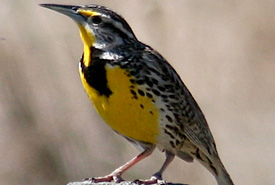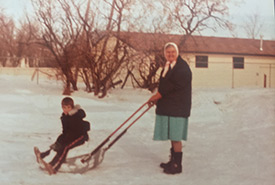What the meadowlark sang to my grandmother

Western meadowlark (Photo by Allison Haskell)
I am not a professional biologist or a fanatical birder like many of my colleagues. I feel like I am surrounded — I mean, it’s Saskatchewan, so it’s tough to feel surrounded by much of anyone or anything — by highly trained biologists who can spot a common merganser in a crowd, who know the difference between the mating call of a Sprague’s pipit and one just chirping about. Professionally, I put myself firmly in the agrologist/range ecologist/plant guy camp. As far as fanatic affiliations, I have been and will always be a Mennonite (kinda like a passive-aggressive fight club, without any fighting). Those are my outs for not being up-to-snuff on bird calls.
So I’m not a birder. But, I have been introduced to this shady underworld, especially with the likes of my colleagues at the Nature Conservancy of Canada (Ryan, Sarah and Mike), and it is interesting and I’m finding my way. Identifying birds at my feeder is relatively straight forward. There is, of course, the help of a great app (Merlin Bird ID) that asks you a few easy-to-answer questions about the bird you saw: “Was it bigger or smaller than a bread box?” “What are the three main colours of the bird you saw?” “Was the bird at a feeder, flying or floating when you saw it?” and then gives you a list of potential matches. I get most of my backyard amateur birding done that way.
But to turn pro, or even semi-pro, I’m going to need to step up my game, and that is where I’m hoping my cultural affiliation will help me out. You see, if you are like me and you do most of your birding by sight and most of your naming by colour and perch (You see that one over there is the little brown fence sitter, ah ― scientific name, Tiniest brauneousbarbarious, I believe), and you want to expand your birding game this spring, you are going to need to learn some songs. Bird songs, or calls. I’ll figure that part out soon. And by some songs, I mean many, and by songs/calls I mean the little tinkling, high-pitch twitterings just into the range of my tinnitus.
The songs practically learn themselves! I mean, how hard is it to distinguish between an American robin and black-headed grosbeak? But if you are like me and you need a little something to aid in remembering a bird’s mating/defensive jingle, you might want to add a few words to the song. Make the song about something. The first person to teach me a mnemonic bird song tried appealing to my stomach and it worked, which is why I still know that the chickadees at my bird feeder would rather have cheeseburgers. Later, in my wilder years, my raunchier birding friend introduced me to bird song lyrics that made me blush and would get me banned from Land Lines if repeated.

Matthew and his grandma (Photo courtesy of Matthew Braun)
Now that I’m older, wiser and reconnecting with my heritage, I’m finding out what my low-German-speaking grandmother heard when the western meadowlark sang to her, “Komm, komm, dee Kjikje sient goare!” It won’t mean anything to you, but it meant something to my grandmother. She knew what bird was singing. She knew it well. My dad reminded me of that song last week, and it got me to thinking that the birds of the prairies probably sing the same songs with different words to many language groups across the prairies. I’m as ignorant of what the killdeer says in Cree as I am of what the yellow-rumped warbler says in Ukrainian, but I bet those songs are out there. Whatever your affiliation ― cultural or professional ― there is a good chance you have a connection to the songs being sung at your feeder right now.
And yeah, knowing which bird is advertising “Quick, free beer” is definitely going to make you the most popular kid at grandma’s this Sunday afternoon. But more importantly, it will give you a connection to birds that come and go from our lives. People have been listening and connecting to birds forever. Because we as a people love nature and want to know more. Now if only I could come up with a rhyme to help me distinguish Hesperostipa curtiseta from Hesperostipa comata.


